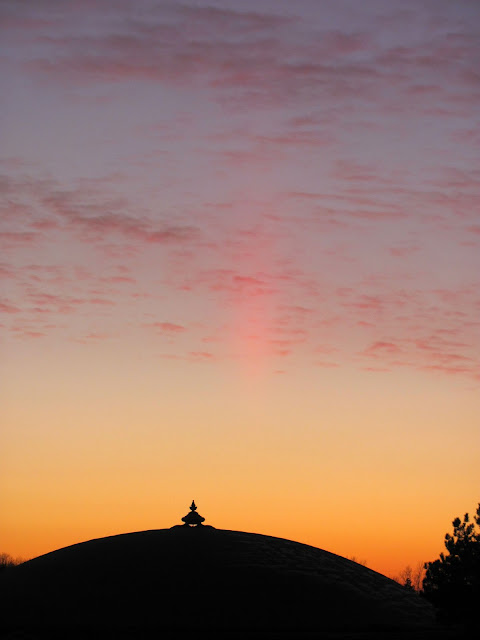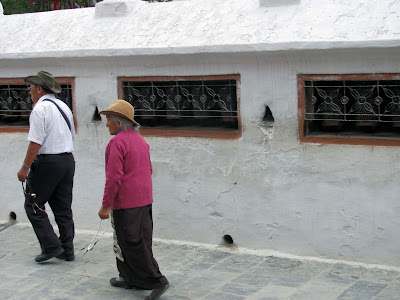from a spirit house
Mathuska Olga's presence
still helps her people
My younger sister feels a strong connection with anything Russian after spending a year there, so when we are in Alaska she drives 25 miles north of Anchorage to see St. Nicholas Russian Orthodox Church at Eklutna Heritage Park. Located on Cook Inlet, Eklutna was settled by the Ta nai na tribe of Athabascans around 800 years ago, and is the oldest inhabited community in the Anchorage area. Russian Orthodox missionaries arrived in the 1840s and built a log church in Knik in 1870, which was moved to Eklutna about 1900. It is considered the oldest log structure in Alaska. A larger clapboard church was built next to it in 1962.
The church reflects a blending of native Athabascan practices with Russian Orthodox Christianity. This is particularly noticeable in the cemetery, established around 1650, with its spirit houses built on top of the graves. The priest who shows us around explains that different styles and colors indicate specific families and a marriage between two families results in a blend of colors.
On a wall inside the church is a painting of Mathuska Olga Michael (1916-1979), a Yu'pik whose husband Nicolai Michael ran the general store and was postmaster for Eklutna, and later Archpriest. Mathuska Olga was also a midwife who gave birth to thirteen children, several without a midwife attending her, and eight of them survived to maturity. She was known for her empathy and caring nature for those who had suffered from abuse, especially sexual abuse. While her husband traveled to other parishes, she kept busy helping others, spending many hours making parkas, boots, socks and mittens not only for her own family but for others. Nearly everyone in the village had something made by her. She died in November, when snow and ice made traveling nearly impossible, but a southerly wind thawed the snow, making the trek possible for parishioners from neighboring villages to attend her funeral. On a spring-like day a flock of birds followed the mourners carrying her coffin and circled above the grave, though all other birds had long since flown south. The unprecedented thaw made it easy to dig the grave in the usually frozen ground, as if the earth opened to receive her. The next evening, the wind began to blow, the ground refroze and winter returned.
Even after she departed, Mathuska Olga continued to provide help to many people. The following account, provided by Fr. John Shimchick of the Orthodox Church of America, comes from a woman who had suffered for many years from the consequences of severe sexual abuse experienced as a child.
"One day I was deeply at prayer and awake. I had remembered an event that was very scary. My prayer began with my asking the Holy Theotokos for help and mercy. Gradually I was aware of standing in the woods feeling still a little scared. Soon a gentle wave of tenderness began to sweep through the woods followed by a fresh garden scent. I saw the Virgin Mary, dressed as she is in an icon, but more natural looking and brighter, walking toward me. As she came closer I was aware of someone walking behind her. She stepped aside and gestured to a short, wise looking woman. I asked her, 'Who are you?' And the Virgin Mary answered, 'St. Olga.'
"St. Olga gestured for me to follow her. We walked a long way until there weren't many trees. We came to a little hill that had a door cut into the side. She gestured for me to sit and she went inside. After a little while some smoke came out of the top of the hill. St. Olga came out with some herbal tea. We both sat in silence drinking our tea and feeling the warmth of the sun of our faces. I began to get a pain in my belly and she led me inside. The door was so low I had to duck like bowing in prayer.
"Inside the hill was dry and warm and very quiet. The light was very soft coming from a shallow bowl and from the open hole on the top of the hill. Everything around me felt gentle, especially Mother Olga. The little hill house smelled like wild thyme and white pine in the sun with roses and violets mixed in. Mother Olga helped me up on a kind of platform bed like a driftwood box filled with moss and grasses. It was soft and smelled like the earth and the sea. I was exhausted and lay back. St. Olga went over to the lamp and warmed up something which she rubbed on my belly. I looked five months pregnant. (I was not pregnant for real at that time.) I started to labor. I was a little scared. Mother Olga climbed up beside me and gently holding by arm, she pretended to labor with me, showing me what to do and how to breath. She still hadn't said anything. She helped me push out some stuff like afterbirth which kind of soaked into dried moss on the box bed. I was very tired and crying a little from relief when it was over.
"Up until this she hadn't spoken, but her eyes spoke with great tenderness and understanding. We both got up and had some tea. As we were drinking it, Holy Mother Olga gradually became the light in the room. Her face looked like there was a strong light bulb or the sun shining under her skin. But I think the whole of her glowed. I was just so connected to her loving gaze that I didn't pay much attention to anything else. It was the kind of loving gaze from a mother to an infant that connects and welcomes a baby to life. She seemed to pour tenderness into me through her eyes. This wasn't scary even though, at that time, I didn't know about people who literally shone with the love of God. I know now that some very deep wounds were being healed at that time. She gave me back by own life which had been stolen, a life that is now defined by the beauty and love of God for me, the restored work of His Hands.
"After some time I felt like I was filled with wellness and a sense of quiet entered my soul, as if my soul had been crying like a grief-stricken abandoned infant and now had finally been comforted. Even now as I write, the miracle of the peacefulness, and also the zest for life which wellness has brought, causes me to cry with joy and awe.
"Only after this did Holy Mother Olga speak. She spoke about God and people who choose to do evil things. She said the people who hurt me thought they could make me carry their evil inside of me by rape. She was very firm when she said, 'That's a lie. Only God can carry evil away. The only thing they could put inside you was the seed of life which is a creation of God and cannot pollute anyone.' I was never polluted. It just felt that way because of the evil intentions of the people near me. What I had held inside me was the pain, terror, shame, and helplessness I felt. We had labored together and that was all out of me now. She burned some grass over the little flame and the smoke went straight up to God who is both the judge and the forgiver. I understood by the 'incense' that it wasn't my job to carry the sins of people against me either. It was God's, and what an ever-unfolding richness this taste of salvation is. At the end of this healing time we went outside together. It was not dark in the visioning prayer. There were so many stars stretching to infinity. The sky was all shimmer with a moving veil of light (the northern lights). Either Matushka Olga said, or we both heard in our hearts, that the moving curtain of light was to be for us a promise that God can create great beauty from complete desolation and nothingness. For me it was like proof of the healing, great beauty where there had been nothing before but despair hidden by shame and great effort."
Matushka Olga, wife of Archpriest Nikolai of St. Nicholas Russian Orthodox Church, member of the Real People as the Native Alaskans call themselves, midwife and healer, a Real Mrs. Santa Claus.








































